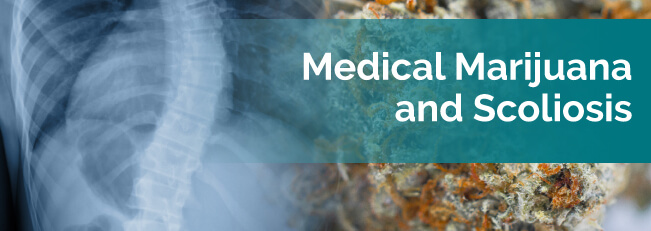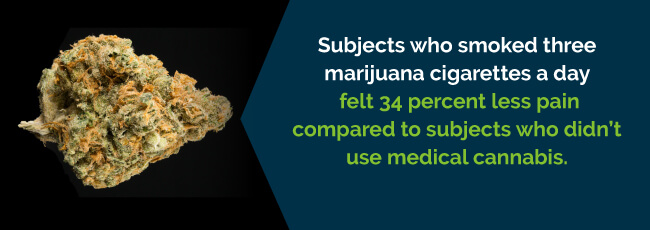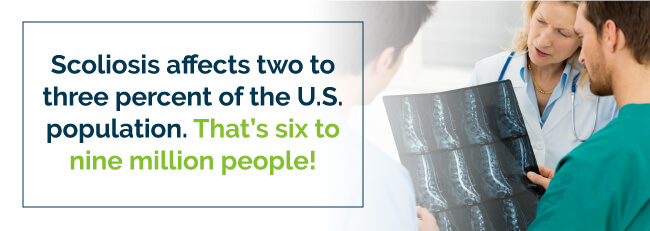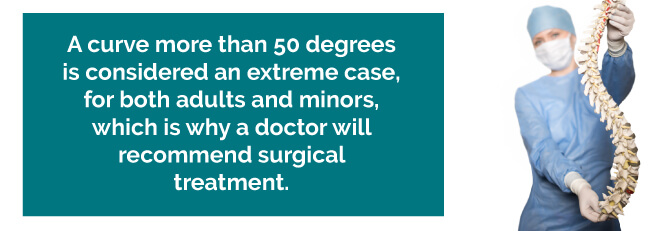
Dealing with scoliosis can be a pain — literally. The more curved your spine becomes due to scoliosis, the more painful it gets. Such severe pain can leave you unable to live your life to the fullest.
Traditionally, a doctor will recommend therapy, bracing or surgery for moderate to severe scoliosis. But, all three of these procedures can increase the pain you feel. They can also further inflame your spine and the surrounding tissue. The increased inflammation can cause swelling and even more pain.
Physicians often prescribe anti-inflammatory medications and painkillers to relieve scoliosis symptoms. But, opiate-based medicine can make you develop a dependency, damage your liver or cause other side effects.
More and more patients use medical marijuana as a substitute for potentially harmful painkillers and sometimes ineffective anti-inflammatory medicine. You can use medical marijuana to improve your recovery strategy and avoid the complications of other medicine.
While some areas of medical marijuana research need more data to show conclusive evidence, the scientific community has closely studied the benefits of medical cannabis as an alternative for pain relief. Many studies examined medical marijuana’s function as a pain reliever and discovered that it soothes pain.
A recent clinical study measured the effectiveness of medical marijuana as a supplement to an opioid-based pain relief regimen. It found that 27 percent of the patients could reduce the number of opiates they had to take while feeling the same level of release from their pain.
Other research examined the pain-relieving properties of medical marijuana for pain patients in general. Subjects who smoked three marijuana cigarettes a day felt 34 percent less pain compared to subjects who didn’t use medical cannabis.
Medical marijuana can also serve as an anti-inflammatory. When reviewing research on the anti-inflammatory effects of cannabinoids, researchers found that they can reduce inflammation caused by a wide range of disorders.
Cannabinoids can relieve the inflammation from arthritis, postoperative pain, fibromyalgia, chronic pain and similar disorders that cause swelling.
Find A Doctor Find A Dispensary
We’ve found out that marijuana has tons of curative properties, but it doesn’t have the ability to realign your spine. Only a trained professional can help put your bones and joints back in place to solve the root of the problem.
However, using medical marijuana for scoliosis can help you cope with its symptoms. If you get surgery to fix your spine, you can also use it to treat post-surgical symptoms.
Chronic pain permeates a scoliosis patient’s life. Bracing and surgery can eventually correct the spine’s curvature, but the pain can still linger for months to years. Also, these physical procedures meant to realign the spine can increase the pain and inflammation that the patient experiences.
Regardless of the treatment phase when a patient feels scoliosis-related pain, medical cannabis can help fight it. Additionally, it has cannabidiol, or CBD, which can reduce inflammation. Less inflammation can mean even less pain.

Some scoliosis patients also deal with chronic fatigue. While you might imagine marijuana as something that can only make you tired, some marijuana strains can energize you while still providing relief from your other symptoms.
One of the biggest advantages of medical marijuana is its versatility. As you can see, it can treat many of your scoliosis symptoms at once. Medical marijuana can make an excellent supplement or substitute for the standard medication you take for scoliosis as well.
The marijuana strain that will work best for you depends on many factors. You should pick a strain that helps your symptoms. But, depending on your physical chemistry and individual preferences, you might have to experiment with different strains to find the best fit for you.
It helps to know how medical marijuana strains are categorized to make an informed decision about the right strain for you. Three strains of medical marijuana are available:
Favorite strains for alleviating scoliosis symptoms include:
Available strains at your local dispensary may vary. If you can’t find one of these strains, talk to your dispensary’s budtender. They’re educated and experienced about their selection, as well as mainstream strains, and can discover one for you that’s similar.
Just like picking a strain, choosing a marijuana treatment method involves many options and a possible need for experimentation. Each method has different degrees of effectiveness that impact your treatment.

Options for using medical weed include:
It’s important to note that state laws vary when it comes to administration methods for medical weed. Some states, for example, haven’t legalized smoking medical cannabis. Most, however, do approve topicals and edibles.
If you need advice on picking a treatment, talk to your doctor or dispensary staff. Everyone has a different body and mind, so they can understand the nuances of your reaction to marijuana and guide your decision.
Even though medical marijuana has numerous benefits, it has side effects just like any other medicine. However, its side effects cause less harm than most traditional medication, and some patients even take it to get effects like increased hunger. Let’s look at each side effect one by one:
Many patients don’t experience each of medical cannabis’ side effects. The most common are hunger, red eyes and drowsiness. As noted above, switching your strain may be all you need to reduce your number of side effects or their intensity.
If you want a holistic alternative to traditional medicine, medical marijuana can change the way you manage your scoliosis. You just need to know where to look!
You should see what medical marijuana laws your state has to understand your medication options. Our collection of legal info can guide the way.
Once you have a grasp on your state’s rules, you can look for a doctor to recommend medical marijuana for you. We provide a comprehensive database of marijuana doctors for your convenience. Another vital decision to make when you start using medical cannabis for scoliosis is which dispensary you get your medicine from —we also have that information in our directory.
Search for a medical cannabis doctor today to begin treating your scoliosis in a new, natural way.
Find A Doctor Find A Dispensary
Scoliosis affects two to three percent of the U.S. population. That’s six to nine million people! The condition often appears during puberty, between the ages of 10 to 15, with females being eight times more likely to develop it than males.

The condition causes your spine to be uneven or out of alignment. A spine with scoliosis can have a curved shape or rotated vertebrae. Doctors classify curves as either an S- or C-curved. Misalignment of the spine can have more consequences than you may think. A normally-shaped spine serves as a shock absorber that distributes the impact from movement.
So, when you have scoliosis, the force from moving puts stress on some places more than others.
This extra stress on your joints and bones results in a variety of health issues. Severe curving can cause joint damage and make your ribs rub against your pelvis and cause pain. It can also lead to lung or breathing complications.
Three different types of scoliosis exist:
Doctors diagnose scoliosis using a multi-step method:
Regular physical exams can lead to an early diagnosis of scoliosis, as well as the start of treatment.
Several different symptoms of scoliosis exist and include:
Not every scoliosis patient will go through the same symptoms. Since scoliosis can appear in different spine sections and vary in curvature, it can cause mild discomfort or alter your posture in a significant, noticeable way.
With scoliosis, 90 percent of cases don’t need treatment. Why such a large percentage? Most people diagnosed with scoliosis are children. Because they’re growing and developing, the issue may resolve itself. That’s why most doctors will monitor your child’s development before recommending treatment.
To decide whether a patient under 18 needs treatment, a physician will consider these factors:
If your practitioner recommends treatment, they will decide the type based on:
Doctors often recommend regular observation for young patients with a small degree of curvature, as well as for adults with a moderate curve. Periodical monitoring allows your physician and you to address any changes in the spine.
For a growing patient, a spine curve between 25 and 45 degrees requires nonoperative treatment. Nonoperative treatments include:
A curve more than 50 degrees is considered an extreme case, for both adults and minors, which is why a doctor will recommend surgical treatment. Your physician may also suggest spinal surgery when the symptoms cause severe discomfort or if you’re bothered by the appearance of your spinal curve.

Corrective surgery for scoliosis is called spinal fusion surgery. In this operation, your doctor binds the curved vertebrae together with a rod. These fused bones than heal as a single, solid bone — similar to how a broken bone heals. To make sure the bones fuse together, surgeons attach a metal rod to your spine.
Two types of scoliosis surgery are available:
If your doctor recommends surgery, make sure to consider all the risks and costs involved. Surgery can limit your movement and does require two to four weeks of rest before returning to school or work. You should also check if your insurance covers the cost of the surgery.
An extensive, four-year study discovered that the average cost of corrective surgery for scoliosis was more than $120,000 in 2010. Additional operations, or reoperations, also cost 70 percent more than the initial surgery cost, revealing the high financial burden of correcting scoliosis with surgery.
After surgery, physicians may prescribe anti-inflammatory pills and painkillers. Even if you don’t undergo the operation, your doctor may recommend these medicines to manage pain. However, prescription drugs don’t always work well for every patient, and painkillers can become addicting and damage your liver.
Scoliosis has a long, extensive history leading up to the development of modern medicine, as well as the standard treatments for the condition, like corrective surgery.
The history of scoliosis begins with Hippocrates in ancient Greece. The Greek physician, known as the “Father of Modern Medicine,” is credited with discovering scoliosis and coming up with the first treatment techniques.
Hippocrates developed the following devices for treatment:
Another Greek physician, Galen of Pergamon, did recommend the Hippocratic board. However, he was skeptical of how effective the use of force was in correcting scoliosis. The focus on pressure later led to medical mishaps in the 1800s.
Before the 19th century, though, a new brace was developed by Ambrose Pare in the 1500s. The French surgeon used iron plates to create the brace, which inspired the corrective braces created more than 100 years later in the 1700 and 1800s.
During these time periods, doctors were also using mechanical beds as treatment. A variety of beds existed, including:
These beds differed in their approaches. Some, like the Maisonabe bed attached weights to patients to create traction and move the spinal cord. In most cases, these beds had little effect on scoliosis. In others, the use of pressure had devastating consequences.
Writings from 1820 highlight how the use of pressure through mechanical traction caused paralysis in some cases. This event led to the formation of a research society to discover new, and safer ways to treat scoliosis.
In the following years, braces became more popular. Throughout the 1800s, several were developed, including:
Physical therapy also began to grow in popularity. Exercises focused on strengthening back muscles, as well as standing up straight. It was the beginning of a movement towards more natural and useful treatments.
When the 1900s arrived, so did the development of the Cobb angle for measuring curves. During this time, doctors thought scoliosis was a disease caused by tuberculosis, poor posture or polio. Even the Milwaukee brace, used for polio, was used for scoliosis.
After the 1960s, doctors realized scoliosis wasn’t a disease. Vaccines for polio and antibiotics for tuberculosis reduced the occurrence of each disease but didn’t lower the rate of scoliosis. As modern medicine grew, so did ways for treating the condition.
And that led to the Harrington rod for spinal surgery. While still common in spinal surgeries today, another instrument, the Cotrel-Dubousset Instrumentation, is also used for corrective spinal surgeries.
Thanks to research, as well as the commitment of physicians, viable treatments are available for scoliosis — including medical marijuana.